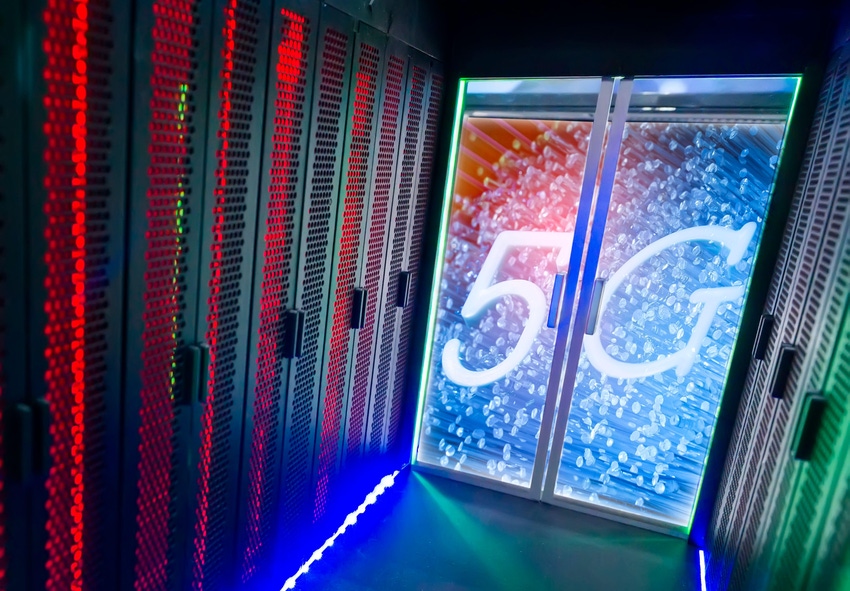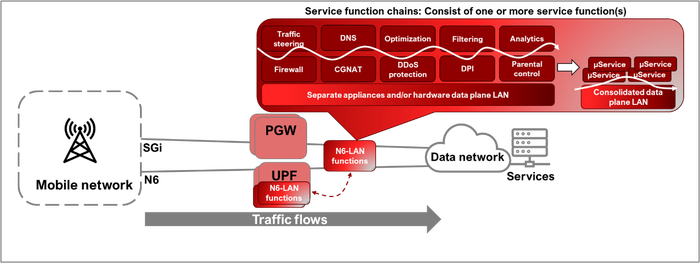N6-LAN: A new generation of data plane LAN service functions for 5G?
5G has changed the mobile network landscape by adding new service types and diverse connections to external cloud and enterprise partners, which places new demands on the data plane LAN.

Operators strive to offer attractive, innovative services that stand out from their competition and meet their customers' high expectations. To achieve this, the entire end-to-end service must perform efficiently. In 5G networks, the N6-LAN (the domain positioned at the edge of the mobile network at the interface to the internet, cloud providers and enterprise networks) gives operators the ability to monitor, optimize and secure different traffic flows.
A few years back, the 4G SGi-LAN was big news and a high priority. Several years on, with a new mobile generation (5G) and a new N6 interface, the data plane LAN (a.k.a. the N6-LAN) seems a little out of the spotlight, awaiting widespread 5G standalone adoption. Many of the functions — security firewalls, traffic steering, deep packet inspection (DPI), optimization and analytics — are still enormously important and give operators opportunities for service distinction.
In the meantime, the landscape has changed and become more demanding. 5G offers more "edges," more service types and more diverse connections to external cloud and enterprise partners. These trends place new demands on the data plane LAN.
The question is: How should operators transition from SGi-LAN to an efficient N6-LAN fit for the new world of 5G cloud services?
4G SGi-LAN and the path to N6-LAN
4G ushered in a new generation of IP-centric voice and data; the SGi-LAN still enables efficiencies, protection and value-add on external IP-based networks. For now, N6-LAN seems a secondary consideration or future aspiration, with many operators still grappling with 5G standalone (SA) core build complexities. Significant generational changes mean the transition from SGi-LAN to N6-LAN must consider new use cases, technology and management methodologies.
Use cases and services: 5G SA service types have become more diverse and complex; low latency applications, network slicing, edge applications, etc., will favor different N6-LAN service functions. For example, traffic steering will become more prevalent with user equipment session-driven and service-aware applications as network slicing becomes more widely available. Demand for content and resource optimization, as well as security service functions to safeguard and observe, remains high and is likely to continue. Additionally, load balancing and analytic functions will remain vital.
Support for multiple generations and technologies: The technology footprint has radically evolved between mobile generations. It now forms a mixed landscape of physical, virtualized and containerized network functions for many operators. The eagerness to embrace new technology and consolidation for efficiency also goes hand-in-hand with cost considerations and ease of management. This trend indicates that potential service function sharing or reuse across mobile generations (e.g., carrier-grade network address translation [CG-NAT] and some security protection appliances) might be applicable.
New protocols: The use of HTTP/3 (the latest version of Hypertext Transfer Protocol) and Quick UDP Internet Connections (QUIC) is growing fast across the internet, with both adding more efficient mechanisms to reduce latency and establish two-way communications. These new transport protocols benefit applications like real-time video streaming and conferencing, growing within 5G. The transition may require adjustments to existing data plane LAN components (e.g., CG-NAT functions) for transiting traffic and quality of experience video monitoring metrics, as QUIC is an encrypted transport protocol. Expected QUIC protocol use for multi-path routing via the access traffic steering, split and switching (ATSSS) network function (for policy-based routing across 3GPP and non-3GPP access) may also require changes.
The right N6-LAN model
Architecturally, the SGi-/N6-LAN is on the periphery of 3GPP standardization with dependencies on the mobile core (e.g., specific dedicated service functions versus in-built UPF capability). Technically, it is closer to the IP and cloud networking worlds. Therefore, N6-LAN will need flexibility and various options (shown in the figure below) to cover the wide-ranging architectures and service requirements of 5G.
Centralized: Many operator networks are still highly centralized, meaning the traditional service function "hub" is still relevant. This architecture is also advantageous where multiple gateways (i.e., user plane functions [UPFs] or packet gateways [PGWs]) will access similar SGi/N6-LAN functions and perhaps offer an interim transition from SGi-LAN to N6-LAN. However, transforming service functions toward a consolidated, single-hop containerized architecture should be the end goal to improve efficiency and reduce service function hops and management.
Distributed: Scenarios may exist where an operator's network contains a mix or high number of distributed UPFs to support different use cases or services (e.g., low latency edge applications, offload, tailored services, etc.). In these situations, colocating service functions at the same hosting location or hardware as the UPF offers multiple efficiencies, especially where microservices already support some or all service functions.
Integrated: Some UPF vendors have previously consolidated and incorporated selected value-added service functions offered on the data plane LAN into their products. Common function categories include DPI and optimization, although some bundle security of analytic capabilities as part of larger product offerings. This trend is likely to continue, but specialist vendor service functions (e.g., DDoS, malware protection, advanced analytics, etc.) will remain standalone.
Service function chains deployable in varying locations

(Source: Heavy Reading)
The evolution of service function chaining
In summary, Heavy Reading sees the following main characteristics and changes to service function chaining as we transition to 5G SA and the N6-LAN:
Consolidation to increase management and cost efficiency (including potential reuse of existing 4G service functions).
Evolution of the traditional service function "hub" to support varying models (e.g., centralized, distributed and integrated).
Support for new capabilities and services in the data plane LAN (e.g., service-aware traffic steering, network slicing, new protocols, etc.).
With the growing pressure for operators to drive service differentiation and revenue, enhancing the data plane LAN will most likely return to focus. Multiple vendors continue to work in this domain, including Ericsson, F5, Juniper, NETSCOUT, Nokia, Spirent, etc., updating and evolving their product capabilities and features. For operators to achieve the best end-to-end customer experience will require developing the current 5G SA data plane LAN to meet the needs of future network services.
About the Author(s)
You May Also Like












